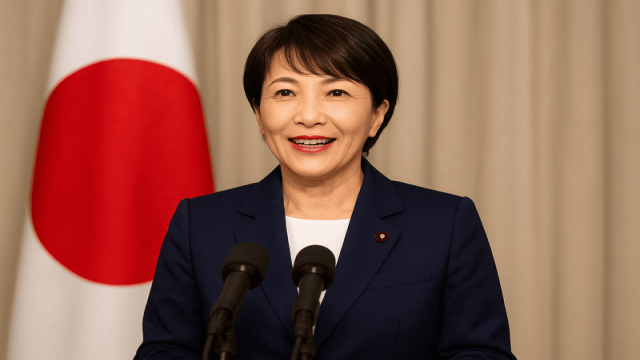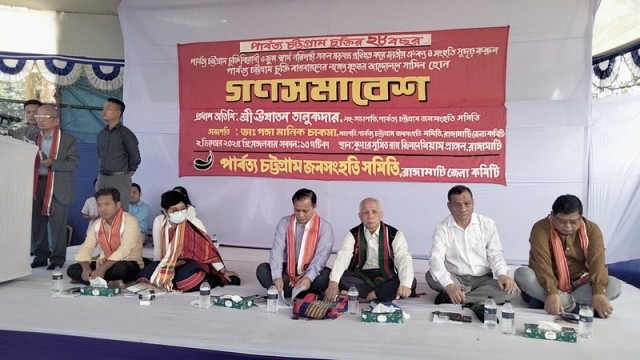Tokyo, Oct 22 (V7N) — Japan has entered a new political era with the election of Sanae Takaichi as the nation’s first female prime minister. Her rise to power marks a historic milestone in a country where politics has long been dominated by men. Elected by majority vote in the National Diet on Tuesday, the 64-year-old conservative leader now faces the enormous challenge of leading one of the world’s largest economies through a period of political, economic, and social uncertainty.
Sanae Takaichi’s victory is both historic and symbolic. She becomes Japan’s 104th prime minister and the first woman ever to lead the government since the country’s parliamentary system began in 1885. Her ascent comes after decades of public debate over women’s representation in Japanese politics and leadership — a subject often seen as one of the nation’s biggest cultural barriers.
Born in Nara Prefecture in 1961, Takaichi graduated from Kobe University with a degree in political science. Early in her career, she worked as a television personality before entering politics in 1993. Over the next three decades, she built a reputation as one of Japan’s most disciplined, conservative, and ambitious politicians. She served as Minister of Internal Affairs and Communications under former Prime Minister Shinzo Abe, who became her mentor and political inspiration.
Takaichi’s political ideology has always aligned with Japan’s nationalist right wing. She is a strong advocate of revising Japan’s postwar pacifist constitution, expanding the role of the Self-Defense Forces, and strengthening the U.S.–Japan alliance. Her foreign policy is shaped by a determination to stand firm against regional threats from China and North Korea while maintaining close strategic ties with Washington.
Her election comes after months of political turbulence. Former Prime Minister Fumio Kishida resigned in early October following plunging approval ratings, party infighting, and criticism over his handling of economic reforms. In the ensuing power struggle within the ruling Liberal Democratic Party (LDP), Takaichi emerged as a compromise candidate between rival factions. She won the LDP leadership election on October 4, 2025, becoming the first woman in party history to do so.
To secure her confirmation as prime minister, the LDP negotiated a last-minute coalition deal with the Japan Innovation Party after its decades-long alliance with Komeito collapsed. During the parliamentary vote, Takaichi received 237 votes in the Lower House — well above the required majority — and was subsequently approved by the Upper House, officially becoming Japan’s first female prime minister.
Immediately after her swearing-in ceremony at the Imperial Palace, Takaichi announced her first Cabinet lineup. She appointed Satsuki Katayama as Finance Minister, Kimi Onoda as Minister for Economic Security, and several veteran lawmakers from the Abe-era circle to key defense and foreign affairs posts. Critics, however, were quick to note that only two women were included in the Cabinet — a move that drew disappointment from reform advocates who had hoped for broader gender representation.
In her first address as prime minister, Takaichi declared her priorities: economic revival, stronger defense, and national pride. “Japan must restore its confidence and lead with strength. I will work, work, and work to protect our people and our sovereignty,” she said.
Her leadership, however, comes with formidable challenges. Japan faces a stagnant economy, record national debt, an aging population, and regional security tensions. Public skepticism also lingers about whether Takaichi’s historic achievement will translate into real progress for women and minorities. Despite breaking the highest political barrier, she has expressed opposition to same-sex marriage and reforms allowing married women to retain their maiden names — positions that have drawn criticism from social progressives.
Economically, Takaichi is expected to pursue policies rooted in fiscal discipline and industrial revitalization. Early signs of optimism appeared in financial markets, with the Nikkei Index reaching record highs after her election — a phenomenon dubbed the “Takaichi Trade.” Analysts say investors see her as a steady hand who will continue pro-business, export-driven policies similar to those of her predecessor.
Internationally, world leaders have congratulated Takaichi, calling her election a significant step for Japan’s democracy. The White House welcomed her commitment to maintaining strong U.S.–Japan relations, while European leaders hailed her as a symbol of progress in Asian politics.
Yet, for many Japanese citizens, her rise carries deeper meaning. In a society where women occupy less than 10 percent of parliamentary seats and gender inequality remains among the widest in developed nations, Takaichi’s victory resonates as both a triumph and a test.
As she takes office, the world watches closely to see whether this historic breakthrough will pave the way for genuine transformation — or whether Japan’s first female prime minister will ultimately reinforce the traditional politics she has long represented.
Summary:
Sanae Takaichi’s election marks an unprecedented moment in Japan’s 140-year parliamentary history. From a television presenter to a political powerhouse, her journey reflects both ambition and resilience. Now, as the nation’s first woman to hold its highest office, she carries the weight of expectation — to prove that her leadership can redefine Japan’s future without erasing its past.
END/SMA/AJ/































Comment: